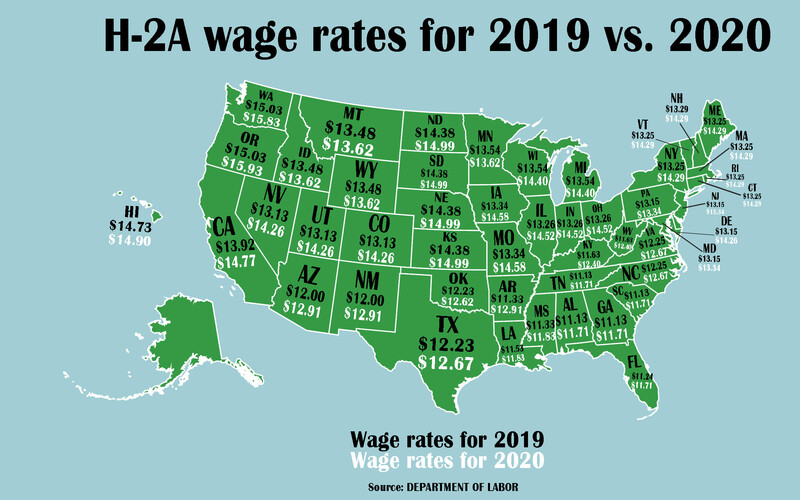As labor shortages continue across agriculture, many growers are wrestling with the option of using the nation’s farm guestworker program. It has been the subject of spirited debate in recent years, playing a critical role in how Congress addresses immigration reform. For many in California, though, the program appears untenable and that assessment is often made on soundbites of information as opposed to a thorough analysis of the program’s requirements, as well as its strengths and weaknesses. The reality is, unless meaningful change happens in short order, many growers need to take the time to learn the program’s specifics and make an educated decision about whether or not it’s the right fit.
The Nuts and Bolts of H2A
The H-2A temporary agricultural program creates a mechanism for US growers to hire foreign workers, on a temporary basis, to address the domestic labor shortages impacting that operation. There are a variety of guestworker visa programs overseen by a network of government agencies, but the H-2A and H-2B programs address the needs of production agriculture. The H-2A program is specifically for laborers that will work on-farm and with the crop in its original state, as opposed to the H-2B program, which is used for temporary jobs beyond the farm but still involving commodities, including packing, shipping and processing.
The H-2A program is overseen by the US Department of Labor, Wage and Hour Division (USDOL), with additional involvement by the US Department of Homeland Security, Citizenship and Immigration Services (USCIS). As can be expected when multiple agencies are involved, the process to secure temporary workers is laborious and includes a number of steps that must be executed in a specific order. The first is validating that, in fact, your operation does not have sufficient domestic labor to fill your needs. This includes proving that you have actively recruited for available positions in line with the program’s domestic hiring requirements. When those efforts have been exhausted, you will submit your temporary labor certification application to USDOL, validating your exhaustive efforts to provide a job to domestic workers.
Keep in mind that ultimately, the government wants to ensure that any willing, able and qualified US worker is given the job. As such, throughout this process, there will be steps that require you to prove you are ensuring US workers are not being adversely impacted by foreign workers. This includes how your existing US workers and these temporary foreign workers are compensated in total, including wages, benefits, housing and transportation made available. More on this shortly.
Once you adequately demonstrate that there are not enough workers, the process of applying to bring in foreign workers begins. The process presumes that you have identified viable foreign candidates and when you submit the second set of paperwork to USCIS, (Form I-129: Petition for Nonimmigrant Worker) you are doing so on behalf of individuals known to you. From a practical perspective, this means you have already invested the time, energy and resources to recruit for the positions needed. You, or those you engage to assist you with this process, will now assist the foreign workers you have identified with their meetings at the US consulate or embassy you designate for them to have their visa applications reviewed. If that process is successful, those foreign workers will be allowed into the country for a maximum of ten months in a twelve-month period, but the specific length of time was determined based on the production need you identified in your application.
There are a number of other responsibilities you take on as the agricultural employer using the H-2A program, including:
Wages: Whether paying an hourly wage or piece rate calculated to the hourly equivalent, foreign workers need to receive, at minimum, the Adverse Effect Wage Rate (an hourly wage determined annually by the USDOL specific to the H-2A program), the contracted rate you guaranteed or minimum wage, whichever is highest.
Transportation: The employer assumes the responsibility for all foreign worker transportation at no cost to them, starting with their trip to the consulate or embassy to secure their visa, then to get to your farming operation from their home country, the day-to-day travel while working for you (including access to transportation options during their time off), and then travel back home once the contract is complete.
Housing and Meals: Foreign workers must be provided housing, at no cost to them, that meets standards set by the Occupational Safety and Health Administration with specific details relative to personal space, bathroom facilities and other elements. In addition, laundry facilities must be provided at no cost and you can either offer free and convenient cooking facilities or provide three nutritious meals each day. If you opt for the latter, you may deduct $12.07 each day from workers’ pay, but doing so must be disclosed at the time of hire, allowing the employee the option to decline the position based on those terms.

Avoid These Common Citations
While agricultural employers are cited by USDOL for a wide variety of employment violations relative to using H-2A, the two most common and costly citations focus on the relationship between US and foreign workers. The agency finds that most often, US workers who are willing, able and qualified are not offered the available jobs. As previously noted, it is essential that if a domestic worker applies for an open position and is capable of doing the work, that the individual is given the opportunity. This is such an important issue, the H-2A program requires you to continue actively advertising your available positions for half the length of the foreign workers’ contract. Meaning, if you are using the program for six months, you must prove that you are still recruiting domestic workers for the first three months of their time in the US.
The other area of issue is that domestic workers doing similar work are adversely impacted by the foreign workers, namely relative to compensation. If you have two harvest crews, one made up of domestic workers and one of H-2A workers, the program expects that the domestic workers will receive higher total compensation. Note that this is total compensation, which means you need to calculate the total cost associated with wages, benefits, housing and transportation for the foreign workers and determine the rate your domestic workers need to be paid that is greater. The alternative is to provide the same benefits to your domestic workers relative to housing and transportation, which is a costly proposition.
In reality, the H-2A guestworker visa program is cumbersome and includes a litany of steps mired in bureaucracy. However, it is still the only viable, legal option currently available to the agricultural industry to fill our meaningful labor shortages. This recap of the program is by no means exhaustive. Each element has a series of additional specific details that must be reviewed to more fully understand the impact to your operation. In addition, it is critical to consider cost. AgSafe recently developed the H-2A Cost Estimator, a tool created with the support of current H-2A program users, designed to provide a more detailed analysis of the true costs of using the program. To learn more about the tool, visit http://www.agsafe.org/h2a-cost-estimator/
For more information about worker safety, human resources, labor relations, pesticide safety or food safety issues, please visit www.agsafe.org, call (209) 526-4400 or email safeinfo@agsafe.org. AgSafe is a 501c3 nonprofit providing training, education, outreach and tools in the areas of safety, labor relations, food safety and human resources for the food and farming industries. Since 1991, AgSafe has educated over 85,000 employers, supervisors, and workers about these critical issues.
















